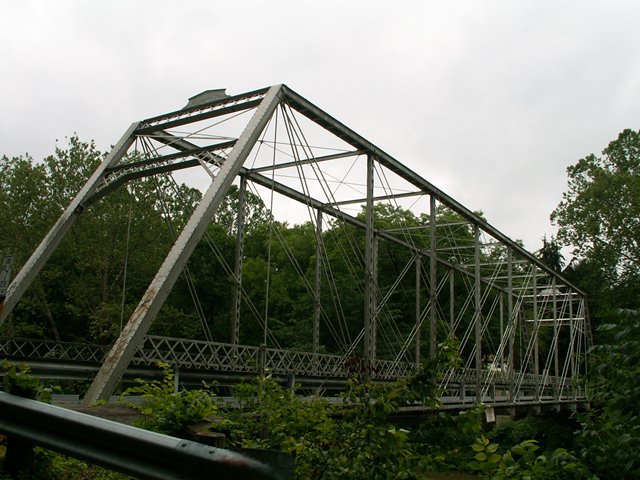We Recommend:
Bach Steel - Experts at historic truss bridge restoration.
Grimms Bridge

Primary Photographer(s): Nathan Holth
Bridge Documented: July 4, 2006
Rural: Columbiana County, Ohio: United States
Metal 10 Panel Pin-Connected Whipple (Double-Intersection Pratt) Through Truss, Fixed
1884 By Builder/Contractor: Wrought Iron Bridge Company of Canton, Ohio
1960
154.0 Feet (46.9 Meters)
155.0 Feet (47.2 Meters)
12 Feet (3.66 Meters)
1 Main Span(s)
1538241

View Information About HSR Ratings
Bridge Documentation
View Archived National Bridge Inventory Report - Has Additional Details and Evaluation
This is a spectacular example of the Wrought Iron Bridge Company's work, a ten panel Whipple through truss with pinned connections. It is a fairly old structure as well, with an 1884 construction date. The bridge has been rehabilitated and as a result remains in good condition todat. Only 1.6 miles shy of being a Pennsylvania bridge, yet this Ohio bridge displays a completely different attitude toward how to treat metal truss bridges. Columbiana, despite demolishing a few bridges, is truss bridge paradise compared to how Pennsylvania treats historic truss bridges. Typical of Columbiana county, the rehabilitation of the Grimms Bridge included completely redoing the flooring system, and the deck is now a metal grate deck. Original lattice railings remain above the modern Armco railings. The bridge has been painted a silver/grey color. An uncommon style of v-lacing is present on the vertical members of the bridge. The lacing is not composed of rounded bars overlapping and sharing a single rivet, but instead a less common design of bars angled to line up with the edges of the vertical member channels are used, and each bar has two rivets at each end, and the bars do not overlap. The portal bracing is a lattice design. Builder plaques remain at both ends of the bridge, although a date plaque is missing in the center of the portal bracing at one end. The other end still has the date plaque though. The portal bracing design and the design of the plaques on it is a typical design for bridges built by the Wrought Iron Bridge Company during this period.
Information and Findings From Ohio's Historic Bridge InventorySetting/Context The bridge carries a 1 lane road over a stream in a sparsely developed, rural setting. Physical Description The 1 span, 155'-long, pin-connected, Whipple thru truss bridge has built-up compression members and eyebar or rod tension members. Integrity Rehabilitated 1997, new floor, sandblasted and painted. Summary of Significance According to county records, the 1884 Whipple thru
truss bridge had its stringers and deck replaced in 1997. It was
painted. There was no adverse effect. The eligible recommendation of the
prior inventory remains appropriate. It is a complete and
technologically significant example of its type/design by a prominent
Ohio fabricator. Justification There are 13 examples of the bridge type important to the development and maturation of the pin-connected thru truss bridge. They date from 1881 and concentrated in the 1880s. Even though there are more than 12 extant examples in Ohio, each built in the 1880s has high significance based on overall scarcity (everywhere but in Ohio) of the design. This is a major and technologically significant bridge type. The bridge has high significance. Bridge Considered Historic By Survey: Yes |
![]()
Photo Galleries and Videos: Grimms Bridge
Bridge Photo-Documentation
Original / Full Size PhotosA collection of overview and detail photos. This gallery offers photos in the highest available resolution and file size in a touch-friendly popup viewer.
Alternatively, Browse Without Using Viewer
![]()
Bridge Photo-Documentation
Mobile Optimized PhotosA collection of overview and detail photos. This gallery features data-friendly, fast-loading photos in a touch-friendly popup viewer.
Alternatively, Browse Without Using Viewer
![]()
Maps and Links: Grimms Bridge
Coordinates (Latitude, Longitude):
Search For Additional Bridge Listings:
Bridgehunter.com: View listed bridges within 0.5 miles (0.8 kilometers) of this bridge.
Bridgehunter.com: View listed bridges within 10 miles (16 kilometers) of this bridge.
Additional Maps:
Google Streetview (If Available)
GeoHack (Additional Links and Coordinates)
Apple Maps (Via DuckDuckGo Search)
Apple Maps (Apple devices only)
Android: Open Location In Your Map or GPS App
Flickr Gallery (Find Nearby Photos)
Wikimedia Commons (Find Nearby Photos)
Directions Via Sygic For Android
Directions Via Sygic For iOS and Android Dolphin Browser
USGS National Map (United States Only)
Historical USGS Topo Maps (United States Only)
Historic Aerials (United States Only)
CalTopo Maps (United States Only)

